The global edible oil market experienced unprecedented price volatility between 2019 and 2024, with the FAO vegetable oils price index reaching levels 50% above baseline during peak periods. Policy interventions, trade restrictions, and supply chain disruptions created cascading effects that transformed manageable supply issues into global food security challenges, demonstrating how interconnected decisions across major producing and consuming nations can amplify market instability far beyond fundamental supply-demand imbalances.
Understanding market interconnectedness through data
Modern commodity markets operate as complex, interconnected systems where policy decisions in one region instantly affect prices globally. Our media intelligence analysis tracked over 400 significant policy interventions and their market impacts during this period, revealing clear patterns between government actions and price volatility that traditional monitoring approaches miss.
The data demonstrates that traditional supply-demand models inadequately explain the extreme price swings observed. Instead, policy-driven market disruptions created artificial scarcity and demand surges that amplified underlying market tensions.
Critical policy interventions and market impact analysis
Indonesia's export restriction strategy
The intervention: In April 2022, Indonesia implemented a complete ban on crude palm oil exports to address domestic cooking oil shortages and inflation pressures.
Market context: Indonesia controls over 50% of global palm oil production, making this intervention a systemic market shock rather than a localized policy adjustment.
Immediate impact:
- Global palm oil prices spiked 40% within two weeks
- Substitution effects drove soybean oil prices up 25%
- Supply chain disruptions affected food manufacturers globally
Early detection success: Semantic Visions' AI-powered monitoring system identified Indonesia's palm oil export ban discussions 72 hours before the official announcement, enabling our clients to implement protective strategies ahead of the market disruption.
Strategic analysis: The intervention demonstrated how domestic food security policies in concentrated markets become global food security risks. The subsequent Domestic Market Obligation (DMO) policy added ongoing uncertainty to export availability, maintaining elevated price volatility long after the initial ban was lifted.
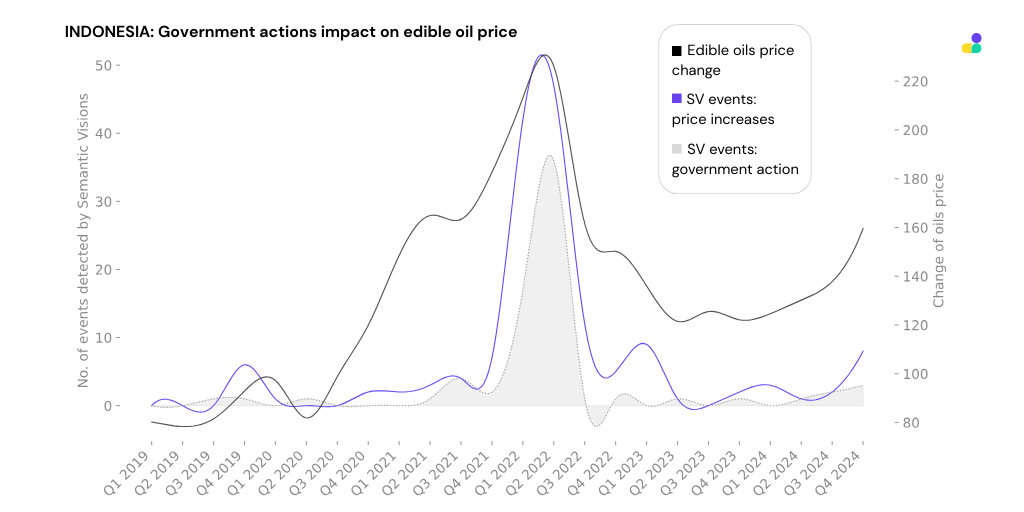
Ukraine-Russia conflict: Supply chain disruption at scale
The disruption: The conflict severely impacted Ukraine's position as the world's largest sunflower oil exporter, reducing exports by over 80% in 2022.
Cascading effects:
- Immediate substitution demand for alternative oils
- Port infrastructure damage created long-term supply constraints
- Black Sea shipping route disruptions affected broader agricultural commodity flows
Market response: The crisis management response varied significantly across consuming nations, with some implementing strategic stockpiling while others relied on market mechanisms, creating uneven demand patterns that amplified price volatility.
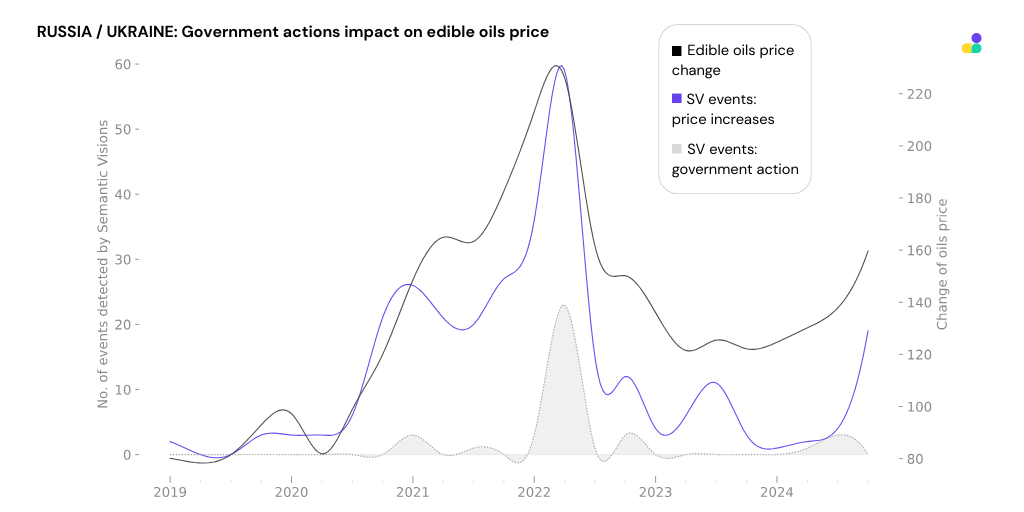
India's demand management through trade policy
Policy approach: India implemented dynamic import duty adjustments, reducing palm oil duties from 15% to 2.5% during price spikes and raising them during market stability.
Strategic impact:
- Created unpredictable demand patterns for global exporters
- Generated policy arbitrage opportunities that distorted natural market pricing
- Demonstrated the challenge of balancing domestic price stability with global market participation
Analysis: As the world's largest edible oil importer, India's policy oscillations created systematic uncertainty in global demand forecasting, contributing to speculative trading behaviors that amplified underlying volatility.
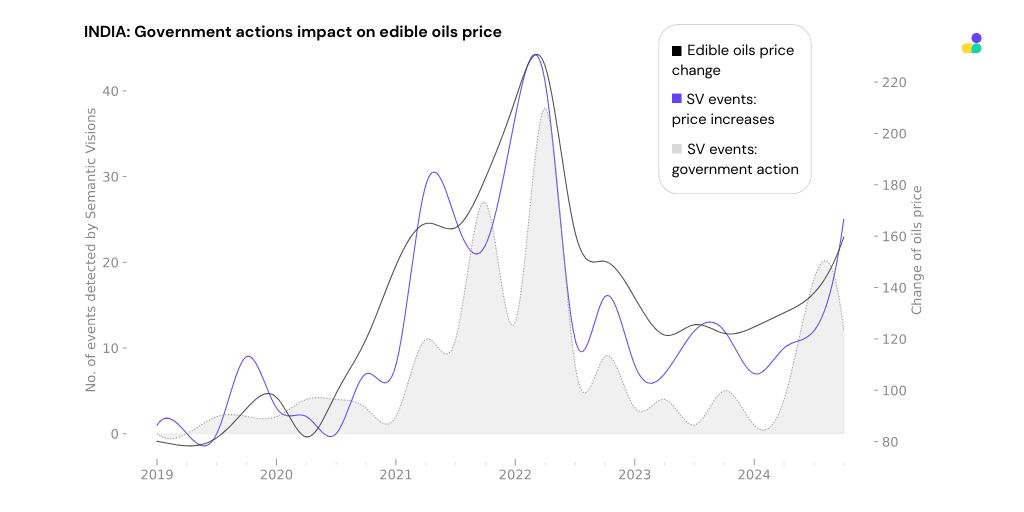
EU, US & Brazil: Policy-driven volatility in interconnected markets
The Disruption: Between 2019 and 2024, biofuel mandates, trade restrictions, and sustainability regulations in the EU, US, and Brazil intensified global edible oil price swings.
Immediate Impact:
- Heightened competition between food and energy sectors for vegetable oils
- Redirected supply flows and temporary shortages
- Price spikes when policy changes coincided with external shocks
Market Response: Our media intelligence shows a strong link between these policy shifts and rapid supply chain risk, as shown in the chart below.
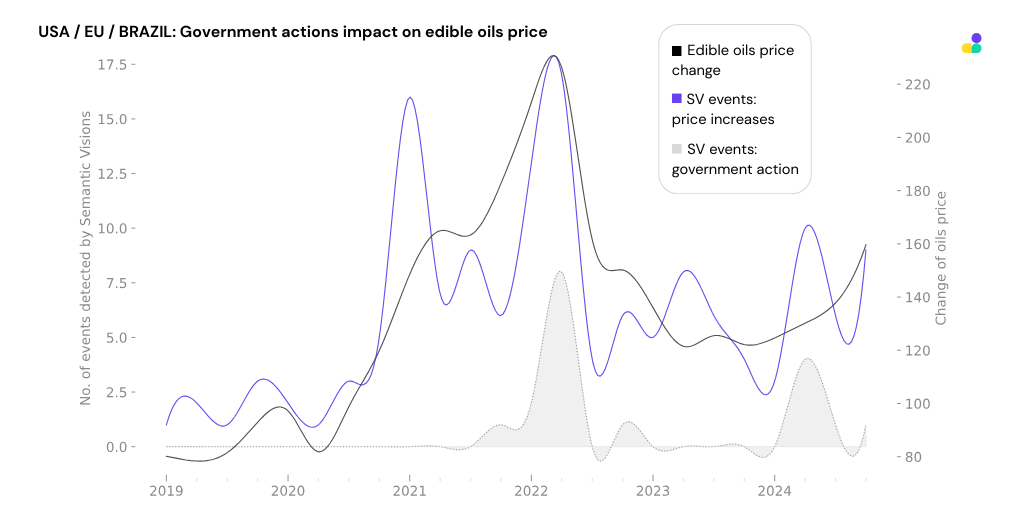
Secondary market drivers and policy interactions
Biofuel mandates and cross-sector competition
Government-mandated biofuel programs in the United States and Brazil created structural competition between food and energy sectors for vegetable oil supplies. This policy-driven demand competed directly with food applications, creating price floors that prevented normal market corrections during periods of oversupply.
Simultaneously, the European Union's decision to phase out palm oil in biofuels by 2030 added long-term uncertainty to producer investment decisions, affecting capacity planning and supply chain strategies.
Labor policy as trade policy: The Malaysia case study
Malaysia's COVID-19 immigration restrictions created unexpected supply chain constraints in palm oil production. Foreign worker visa delays reduced plantation productivity precisely when high prices should have incentivized increased output.
Key insight: This case demonstrates how seemingly unrelated policies (immigration, public health) can become de facto trade interventions with global commodity market implications.
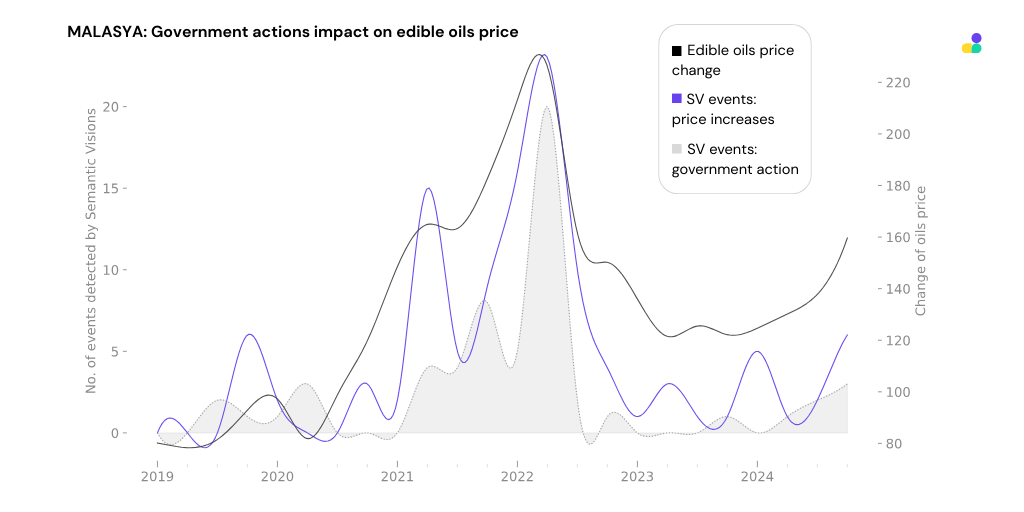
Environmental regulation and trade flow disruption
The European Union's 2023 deforestation-free supply chain requirements introduced new compliance costs and complexity to palm oil and soy oil imports. While environmentally motivated, these regulations created additional uncertainty in trade flows and pricing.
Strategic Implication: Environmental policies increasingly intersect with food commodity markets, requiring businesses to account for sustainability compliance as a price factor.
What the data reveals
Using Semantic Visions' proprietary pattern recognition algorithms, we've identified predictive indicators that consistently appear before major market disruptions:
Policy timing and market impact
- Reactive policies during crisis periods: Amplified volatility by 35% on average compared to baseline market conditions
- Gradual policy implementation: Reduced market shock effects by up to 60%
- Coordinated multi-country policies: Showed 40% less market disruption than unilateral actions
Substitution effect predictability
Market analysis shows predictable substitution ratios during supply disruptions:
- Palm oil restrictions drive 70% of demand to soybean oil, 30% to sunflower oil
- Sunflower oil shortages create 80% soybean oil substitution, 20% to other alternatives
- Price correlation coefficients between substitute oils increased from 0.6 to 0.85 during crisis periods
Where risk concentrates
High-risk dependencies identified:
- 50% of palm oil from Indonesia
- 45% of sunflower oil from Ukraine
- 60% of global imports concentrated in top 5 importing countries
This concentration creates systemic vulnerabilities where single-country policy decisions generate global impacts.
What this means for supply chains
Supply chain managers
Immediate actions:
- Implement multi-source procurement across at least 3 geographic regions
- Establish strategic inventory buffers based on concentration risk analysis
- Develop flexible procurement contracts that accommodate price volatility
Monitoring requirements:
- Track policy discussions in major producing countries through media intelligence platforms
- Monitor government actions indicators for proactive risk assessment
- Implement real-time supply chain management across multiple tiers
Risk management teams
Assessment framework:
- Develop scenario planning models incorporating policy intervention probabilities
- Establish hedging strategies that account for policy-driven volatility patterns
- Create rapid response protocols for major policy announcements
Intelligence integration:
- Utilize media intelligence tools to track policy discourse and sentiment shifts
- Monitor social and political indicators in key producing regions
- Implement automated alert systems for critical policy developments
From signals to strategy
Modern media intelligence platforms provide unprecedented visibility into policy developments and market sentiment shifts. Advanced natural language processing capabilities can identify early warning signals from government communications, policy discussions, and market commentary across multiple languages and regions.
Recommended capabilities:
- Real-time monitoring of policy discussions and government actions
- Sentiment analysis of market participant communications
- Automated correlation analysis between policy announcements and price movements
- Multi-language monitoring of regional policy developments
From volatility to visibility
The 2019-2024 period demonstrates that traditional commodity risk management approaches are insufficient for today's interconnected, policy-sensitive markets. Organizations must evolve their strategies to account for policy risk as a primary market driver rather than a secondary consideration.
Strategic imperatives:
- Enhanced policy monitoring: Implement systematic tracking of policy developments in key producing and consuming nations
- Diversified supply strategies: Reduce dependency on concentrated supply sources through strategic diversification
- Advanced analytics integration: Utilize media intelligence and predictive analytics for early warning systems
- Flexible commercial structures: Develop procurement and sales strategies that accommodate policy-driven volatility
Conclusion
The edible oil market's extreme volatility between 2019 and 2024 resulted from policy interventions that amplified rather than mitigated underlying market pressures. While countries will continue to prioritize domestic food security, the global food system's interconnectedness requires more sophisticated approaches to both policy design and business strategy.
Organizations that invest in advanced monitoring capabilities, diversified supply strategies, and policy risk assessment will be better positioned to navigate future market disruptions. The key insight from this period is that successful commodity market participation now requires treating policy risk as a fundamental market driver deserving systematic management attention.
Success in volatile commodity markets requires comprehensive visibility, strategic diversification, and proactive risk management. Semantic Visions specializes in providing advanced media intelligence solutions that help organizations monitor policy developments, assess supply chain risks, and make data-driven decisions in complex global markets. Contact our team to learn how we can enhance your market monitoring capabilities.
See Everything. Focus on What Matters.
svEye™ filters the noise to uncover meaningful patterns and insights. Gain clarity, stay informed, and drive smarter decisions with a comprehensive overview.




.avif)


